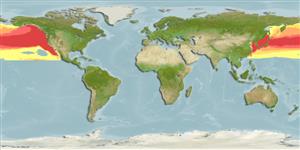>
Beloniformes (Needle fishes) >
Scomberesocidae (Sauries)
Etymology: Cololabis: Greek, kolos = short, truncated + Latin, labia = lips (Ref. 45335); saira: From the Japanese word 'saira' meaning spear (Ref. 6885).
Environment: milieu / climate zone / depth range / distribution range
Ekologi
laut; oceanodromus (Ref. 51243); kisaran kedalaman 0 - 230 m (Ref. 9339). Subtropical; 67°N - 18°N, 117°E - 108°W (Ref. 54338)
North Pacific: Korea (Ref. 37630) and Japan eastward to Gulf of Alaska and southward to Mexico. Highly migratory species.
Length at first maturity / Size / Weight / umur
Maturity: Lm 23.7, range 25 - 28 cm
Max length : 40.0 cm SL jantan/; (Ref. 39882); Berat maksimum terpublikasi: 180.00 g (Ref. 56527); Umur maksimum dilaporkan: 4 Tahun (Ref. 72462)
deskripsi pendek
Kunci identifiaksi (pengenalan) | Morfologi | Morfometrik
Duri punggung (Keseluruhan (total)) : 0; duri punggung lunak (Keseluruhan (total)) : 9 - 12; Duri dubur: 0; Sirip dubur lunak: 12 - 15; vertebrata, bertulang belakang: 62 - 69. Caudal fin broadly and finely forked; pectorals small, truncate, first ray notably flattened (Ref. 6885). Dark green to blue on dorsal surface, silvery below, small bright blue blotches distributed haphazardly on sides; fins on lower part of body pale, others with darkened rays (Ref. 6885). Branchiostegal rays: 12-15 (Ref. 36573).
Adults are generally found offshore, usually near surface, in schools (Ref. 2850). Juveniles associate with drifting seaweed (Ref. 12114, 12115). Feed on small crustaceans, and eggs and larvae of fishes. May glide above the surface of the water when moving away from predators. Prey of Thunnus alalunga and other scombrids (Ref. 9339). Oviparous, with larvae neustonic (Ref. 36573). Eggs are attached to one another and to floating objects via filaments on the shell surface (Ref. 36573). Utilized dried or salted, canned and frozen; also used for fishmeal and pet food; can be pan-fried and broiled (Ref. 9988).
Eschmeyer, W.N., E.S. Herald and H. Hammann, 1983. A field guide to Pacific coast fishes of North America. Boston (MA, USA): Houghton Mifflin Company. xii+336 p. (Ref. 2850)
Status IUCN Red List (Ref. 130435: Version 2024-1)
ancaman kepada manusia
Harmless
penggunaan manusia
Perikanan: bernilai komersial tinggi
Alat, peralatan
laporan khas
muat turun XML
Sumber internet
Estimates based on models
Preferred temperature (Ref.
123201): 4.6 - 14.8, mean 8 °C (based on 99 cells).
Phylogenetic diversity index (Ref.
82804): PD
50 = 0.7812 [Uniqueness, from 0.5 = low to 2.0 = high].
Bayesian length-weight: a=0.00240 (0.00124 - 0.00464), b=3.15 (2.97 - 3.33), in cm total length, based on LWR estimates for this species & (Sub)family-body (Ref.
93245).
Trophic level (Ref.
69278): 3.7 ±0.44 se; based on food items.
Daya lenting (Ref.
120179): Tinggi, Waktu penggandaan populasi minimum kurang dari 15 bulan (K=0.3-0.6; tmax=2).
Prior r = 0.94, 95% CL = 0.62 - 1.41, Based on 2 data-limited stock assessments.
Fishing Vulnerability (Ref.
59153): Low to moderate vulnerability (32 of 100).
Climate Vulnerability (Ref.
125649): Low vulnerability (25 of 100).
Nutrients (Ref.
124155): Calcium = 162 [60, 372] mg/100g; Iron = 1.51 [0.75, 3.55] mg/100g; Protein = 17.6 [15.5, 19.6] %; Omega3 = 0.407 [0.193, 1.210] g/100g; Selenium = 31 [15, 63] μg/100g; VitaminA = 19 [6, 70] μg/100g; Zinc = 0.738 [0.515, 1.100] mg/100g (wet weight);
